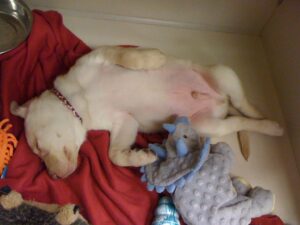Dogs can learn to love their crate as their very own cozy den. It can become a familiar and safe place to be, whether it’s in the car, at a hotel, visiting friends, or just hanging out at home. We have put together a couple of tips to keep in mind while crate training your puppy.
Most importantly, the puppy needs to see the crate as a positive place to be, NEVER as a place for punishment. Do not push your dog into a crate or close the door on them if they are not relaxed and willing to be there. Try to get your dog to walk in on their own and immediately give them praise or a treat for going in. Spend some time with the crate door open and toss treats or a toy in for your puppy to go retrieve, making them associate the crate with a positive experience. Make it a general rule to never close them in the crate unless they are relaxed and comfortable. This rule applies to both puppies and adult dogs, not just during training, but every single time you put your dog in a crate.
Crates should be large enough for the dog to stand, sit and stretch out. Keep in mind that keeping dogs in a crate that is TOO large can interfere with potty training and teach them to go potty in their sleeping/living quarters. Also, assume that anything left in the crate with them will be chewed on. Keep this in mind when leaving them with bedding, toys or potty pads as ingesting these materials can cause serious injury! Puppies that do not chew on blankets can absolutely have a blanket or bed with them in the crate (and may love it if you pop that blanket in the dryer first- cozy warm!) however, if they show interest in chewing their bed up, most puppies do just fine with sleeping on the bare crate floor.
Keep the crate in the kitchen or family room— or, move it around with you. It’s best not to leave them in the back room or basement but rather in an area where they can observe and be close to their new family. If possible, put the crate in your bedroom at night. Not only does this provide comfort, but your own sleeping patterns will encourage the puppy when family bedtime is.
Try to NOT take your puppy out of a crate when he is crying or barking, as that only rewards bad behavior and teaches them that if they whine enough, they get to come out. Wait until they have stopped barking or whining for about five minutes, and then take them out with a big welcome and a treat. Be sure to give lots of praise while your puppy is in the crate, lengthening the periods of time that you leave him by 5-15 minutes. It’s best to have the crate routine begin as soon as you bring your puppy home. Close the content puppy in the crate at regular 1-to-2-hour intervals, and whenever he must be left alone, working up to 3 or 4 hours if needed. A water and/or food bowl can be left with your puppy if you are gone for an extended period of time.
Crate training your puppy does NOT take the place of potty training. Ideally, you will want to continue to train your puppy to go outside or to a designated potty area and not eliminate in the crate. Remember, it is unnatural for the dog to eliminate in the same place where they eat and sleep. It is best to encourage your puppy to go potty right before they go in the crate and immediately after you let them out.
Happy Crate Training!


